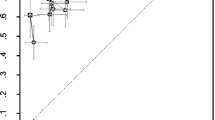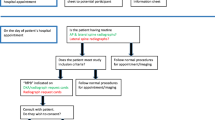Abstract
Summary
Two radiologists evaluated images of the spine from computed tomography (CT) scans on two occasions to diagnose vertebral fracture in 100 individuals. Agreement was fair to good for mild fractures, and agreement was good to excellent for more severe fractures. CT scout views are useful to assess vertebral fracture.
Introduction
We investigated inter-reader agreement between two radiologists and intra-reader agreement between duplicate readings for each radiologist, in assessment of vertebral fracture using a semi-quantitative method from lateral scout views obtained by CT.
Methods
Participants included 50 women and 50 men (age 50-87 years, mean 70 years) in the Framingham Study. T4-L4 vertebrae were assessed independently by two radiologists on two occasions using a semi-quantitative scale as normal, mild, moderate, or severe fracture.
Results
Vertebra-specific prevalence of grade ≥1 (mild) fracture ranged from 3% to 5%. We found fair (κ = 56-59%) inter-reader agreement for grade ≥1 vertebral fractures and good (κ = 68-72%) inter-reader agreement for grade ≥2 fractures. Intra-reader agreement for grade ≥1 vertebral fracture was fair (κ = 55%) for one reader and excellent for another reader (κ = 77%), whereas intra-reader agreement for grade ≥2 vertebral fracture was excellent for both readers (κ = 76% and 98%). Thoracic vertebrae were more difficult to evaluate than the lumbar region, and agreement was lowest (inter-reader κ = 43%) for fracture at the upper (T4-T9) thoracic levels and highest (inter-reader κ = 76-78%) for the lumbar spine (L1-L4).
Conclusions
Based on a semi-quantitative method to classify vertebral fractures using CT scout views, agreement within and between readers was fair to good, with the greatest source of variation occurring for fractures of mild severity and for the upper thoracic region. Agreement was good to excellent for fractures of at least moderate severity. Lateral CT scout views can be useful in clinical research settings to assess vertebral fracture.


Similar content being viewed by others
References
(2004) Bone health and osteoporosis: a report of the surgeon general. In. US Department of Health and Human Services, Office of the Surgeon General, Rockville, MD
Melton LJ 3rd, Lane AW, Cooper C, Eastell R, O'Fallon WM, Riggs BL (1993) Prevalence and incidence of vertebral deformities. Osteoporos Int 3:113–119
Davies KM, Stegman MR, Heaney RP, Recker RR (1996) Prevalence and severity of vertebral fracture: the Saunders County Bone Quality Study. Osteoporos Int 6:160–165
Woolf AD, Pfleger B (2003) Burden of major musculoskeletal conditions. Bull World Health Organ 81:646–656
Johnell O, Kanis JA (2006) An estimate of the worldwide prevalence and disability associated with osteoporotic fractures. Osteoporos Int 17:1726–1733
Burge R, Dawson-Hughes B, Solomon DH, Wong JB, King A, Tosteson A (2007) Incidence and economic burden of osteoporosis-related fractures in the United States, 2005-2025. J Bone Miner Res 22:465–475
Edmond SL, Kiel DP, Samelson EJ, Kelly-Hayes M, Felson DT (2005) Vertebral deformity, back symptoms, and functional limitations among older women: the Framingham Study. Osteoporos Int 16:1086–1095
Melton LJ 3rd (2003) Adverse outcomes of osteoporotic fractures in the general population. J Bone Miner Res 18:1139–1141
Oleksik A, Lips P, Dawson A, Minshall ME, Shen W, Cooper C, Kanis J (2000) Health-related quality of life in postmenopausal women with low BMD with or without prevalent vertebral fractures. J Bone Miner Res 15:1384–1392
Cauley JA, Hochberg MC, Lui LY, Palermo L, Ensrud KE, Hillier TA, Nevitt MC, Cummings SR (2007) Long-term risk of incident vertebral fractures. Jama 298:2761–2767
Lau E, Ong K, Kurtz S, Schmier J, Edidin A (2008) Mortality following the diagnosis of a vertebral compression fracture in the Medicare population. J Bone Joint Surg Am 90:1479–1486
Hasserius R, Karlsson MK, Jonsson B, Redlund-Johnell I, Johnell O (2005) Long-term morbidity and mortality after a clinically diagnosed vertebral fracture in the elderly—a 12- and 22-year follow-up of 257 patients. Calcif Tissue Int 76:235–242
Freedman BA, Potter BK, Nesti LJ, Giuliani JR, Hampton C, Kuklo TR (2008) Osteoporosis and vertebral compression fractures—continued missed opportunities. Spine J 8:756–762
Simon M (2002) Recognition of osteoporosis since 1997. Am J Public Health 92:1707
Siris ES, Bilezikian JP, Rubin MR, Black DM, Bockman RS, Bone HG, Hochberg MC, McClung MR, Schnitzer TJ (2003) Pins and plaster aren't enough: a call for the evaluation and treatment of patients with osteoporotic fractures. J Clin Endocrinol Metab 88:3482–3486
Black DM, Palermo L, Nevitt MC, Genant HK, Epstein R, San Valentin R, Cummings SR (1995) Comparison of methods for defining prevalent vertebral deformities: the study of osteoporotic fractures. J Bone Miner Res 10:890–902
Ferrar L, Jiang G, Schousboe JT, DeBold CR, Eastell R (2008) Algorithm-based qualitative and semiquantitative identification of prevalent vertebral fracture: agreement between different readers, imaging modalities, and diagnostic approaches. J Bone Miner Res 23:417–424
Fuerst T, Wu C, Genant HK, von Ingersleben G, Chen Y, Johnston C, Econs MJ, Binkley N, Vokes TJ, Crans G, Mitlak BH (2009) Evaluation of vertebral fracture assessment by dual X-ray absorptiometry in a multicenter setting. Osteoporos Int 20:1199–1205
Damiano J, Kolta S, Porcher R, Tournoux C, Dougados M, Roux C (2006) Diagnosis of vertebral fractures by vertebral fracture assessment. J Clin Densitom 9:66–71
Chapurlat RD, Duboeuf F, Marion-Audibert HO, Kalpakcioglu B, Mitlak BH, Delmas PD (2006) Effectiveness of instant vertebral assessment to detect prevalent vertebral fracture. Osteoporos Int 17:1189–1195
Gilsanz V, Loro ML, Roe TF, Sayre J, Gilsanz R, Schulz EE (1995) Vertebral size in elderly women with osteoporosis. Mechanical implications and relationship to fractures. J Clin Invest 95:2332–2337
Takada M, Wu CY, Lang TF, Genant HK (1998) Vertebral fracture assessment using the lateral scoutview of computed tomography in comparison with radiographs. Osteoporos Int 8:197–203
Schousboe JT, Debold CR (2006) Reliability and accuracy of vertebral fracture assessment with densitometry compared to radiography in clinical practice. Osteoporos Int 17:281–289
Jiang G, Eastell R, Barrington NA, Ferrar L (2004) Comparison of methods for the visual identification of prevalent vertebral fracture in osteoporosis. Osteoporos Int 15:887–896
Szulc P, Munoz F, Marchand F, Sornay-Rendu E, Delmas PD (2003) Similar prevalence of vertebral fractures despite different approaches to define reference data. Bone 32:441–448
Grados F, Roux C, de Vernejoul MC, Utard G, Sebert JL, Fardellone P (2001) Comparison of four morphometric definitions and a semiquantitative consensus reading for assessing prevalent vertebral fractures. Osteoporos Int 12:716–722
Rea JA, Chen MB, Li J, Blake GM, Steiger P, Genant HK, Fogelman I (2000) Morphometric X-ray absorptiometry and morphometric radiography of the spine: a comparison of prevalent vertebral deformity identification. J Bone Miner Res 15:564–574
Leidig-Bruckner G, Genant HK, Minne HW, Storm T, Thamsborg G, Bruckner T, Sauer P, Schilling T, Soerensen OH, Ziegler R (1994) Comparison of a semiquantitative and a quantitative method for assessing vertebral fractures in osteoporosis. Osteoporos Int 4:154–161
Moselewski F, O'Donnell CJ, Achenbach S, Ferencik M, Massaro J, Nguyen A, Cury RC, Abbara S, Jang IK, Brady TJ, Hoffmann U (2005) Calcium concentration of individual coronary calcified plaques as measured by multidetector row computed tomography. Circulation 111:3236–3241
Dawber TR, Meadors GF, Moore FE (1951) Epidemiological approaches to heart disease: the Framingham Study. Am J Publ Health 41:279–286
Feinleib M, Kannel WB, Garrison RJ, McNamara PM, Castelli WP (1975) The Framingham Offspring Study. Design and preliminary data. Prev Med 4:518–525
Splansky GL, Corey D, Yang Q, Atwood LD, Cupples LA, Benjamin EJ, D'Agostino RB Sr, Fox CS, Larson MG, Murabito JM, O'Donnell CJ, Vasan RS, Wolf PA, Levy D (2007) The Third Generation Cohort Of The National Heart, Lung, and Blood Institute's Framingham Heart Study: design, recruitment, and initial examination. Am J Epidemiol 165:1328–1335
Pou KM, Massaro JM, Hoffmann U, Lieb K, Vasan RS, O'Donnell CJ, Fox CS (2009) Patterns of abdominal fat distribution: the Framingham Heart Study. Diab Care 32:481–485
Genant HK, Wu CY, van Kuijk C, Nevitt MC (1993) Vertebral fracture assessment using a semiquantitative technique. J Bone Miner Res 8:1137–1148
Hoffmann U, Massaro JM, Fox CS, Manders E, O'Donnell CJ (2008) Defining normal distributions of coronary artery calcium in women and men (from the Framingham Heart Study). Am J Cardiol 102:1136–1141, 1141 e1131
Lenchik L, Rogers LF, Delmas PD, Genant HK (2004) Diagnosis of osteoporotic vertebral fractures: importance of recognition and description by radiologists. AJR Am J Roentgenol 183:949–958
Cohen J (1960) A coefficient of agreement for nominal scales. Educ Psychol Meas 20:37–46
Fleiss J (1981) The measurement of interrater agreement. In: Statistical method for rates and proportions. Wiley, New York, pp 211–236
Hospers IC, van der Laan JG, Zeebregts CJ, Nieboer P, Wolffenbuttel BH, Dierckx RA, Kreeftenberg HG, Jager PL, Slart RH (2009) Vertebral fracture assessment in supine position: comparison by using conventional semiquantitative radiography and visual radiography. Radiology 251:822–828
Zmuda JM, Cauley JA, Glynn NW, Finkelstein JS (2000) Posterior-anterior and lateral dual-energy X-ray absorptiometry for the assessment of vertebral osteoporosis and bone loss among older men. J Bone Miner Res 15:1417–1424
Olmez N, Kaya T, Gunaydin R, Vidinli BD, Erdogan N, Memis A (2005) Intra- and interobserver variability of Kleerekoper's method in vertebral fracture assessment. Clin Rheumatol 24:215–218
Kleerekoper MPA, Ellis BI (1984) Measurement of vertebral fracture rates in osteoporosis. In: Christiansen C, Nordin BEC, Parfitt AM, Peck WA, Riggs BL (eds) Copenhagen International Symposium on Osteoporosis. Department of Clinical Chemistry, Glostrup Hospital, Copenhagen, pp 103–109
Bauer JS, Muller D, Ambekar A, Dobritz M, Matsuura M, Eckstein F, Rummeny EJ, Link TM (2006) Detection of osteoporotic vertebral fractures using multidetector CT. Osteoporos Int 17:608–615
Muller D, Bauer JS, Zeile M, Rummeny EJ, Link TM (2008) Significance of sagittal reformations in routine thoracic and abdominal multislice CT studies for detecting osteoporotic fractures and other spine abnormalities. Eur Radiol 18:1696–1702
Williams AL, Al-Busaidi A, Sparrow PJ, Adams JE, Whitehouse RW (2009) Under-reporting of osteoporotic vertebral fractures on computed tomography. Eur J Radiol 69:179–183
Woo EK, Mansoubi H, Alyas F (2008) Incidental vertebral fractures on multidetector CT images of the chest: prevalence and recognition. Clin Radiol 63:160–164
Acknowledgments
This work was supported by NIH R01AR053986, R01AR/AG041398, K01 AR053118, T32 AG023480, and by the National Heart, Lung, and Blood Institute (NHLBI) Framingham Heart Study (NIH/NHLBI Contract N01-HC-25195).
Conflict of interest
None.
Author information
Authors and Affiliations
Corresponding author
Rights and permissions
About this article
Cite this article
Samelson, E.J., Christiansen, B.A., Demissie, S. et al. Reliability of vertebral fracture assessment using multidetector CT lateral scout views: the Framingham Osteoporosis Study. Osteoporos Int 22, 1123–1131 (2011). https://doi.org/10.1007/s00198-010-1290-6
Received:
Accepted:
Published:
Issue Date:
DOI: https://doi.org/10.1007/s00198-010-1290-6




